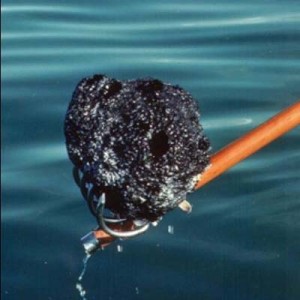How Sea Sponges Are Processed for Use
All sponges are a dark brown when they are first harvested. It is only after processing that sponges take on the brown or light tan color that most consumers are familiar with. Processing sea sponges for use is a multi-step process that begins on the boats right after the sponges are harvested. The process begins with cleaning all of the unwanted tissue and any debris from of the sponge.
Harvesting and Cleaning Natural Sea Sponges

Sea sponges are cleaned through a process that requires several steps. Once removed from the water the living tissue begins to breakdown. The sponges are covered with wet burlap and left on the deck for several days where the heat of the sun and the damp of the burlap help with the removal of the non-skeletal tissue; if the outer skin dries out and hardens, the sponges become worthless. The sponges are then squeezed, or “paddled”, to remove all of the unwanted tissue until only the skeleton of the sponge remains.
During this messy cleaning, or curing, process, the tough outer black skin, gurry and the debris from the sponge’s canals are removed. The market price of a sponge is determined, in large part, by how well the sponges have been cleaned. After cleaning, the sponges are rinsed and hung to dry before being sent to a sponge processing warehouse.
Processing Natural Sea Sponges
After arriving at the warehouse, the sponges begin the processing stage of preparation for sale. The raw sponges are first soaked in water and then partially dried to the point where the sponges are still damp, but the excess water has been removed. The damp sponges, which are easier to cut than when dry, are then trimmed to remove any remaining roots or any other unwanted portions. The trimmed sponges are then sorted by quality and those that are well-rounded and symmetrical are set aside to be processed and sold as “form” sponges, which are also suitable for decoration, and “cut” sponges that have more working surface area.
Once the sponges are trimmed and separated, they are soaked in a weak solution of acid overnight to remove any remaining bits of root, skin, gurry, sand (or any other debris) that may have been missed in the other cleaning processes. The sponges are then removed from the solution and washed, often in large commercial washing machines, with a soda solution that not only neutralizes the acid and removes any remaining particles form the sponge, but also lightens the color of the sponge. The washing time and amount of acid used ultimately determine the color and texture of the finished sponge; this is the most delicate part of the process and requires a high level of skill and expertise. The sponges are then sent to the drying room and allowed to dry completely before being shipped to our retailers.
The Finished Natural Sea Sponge
The finished sea sponges (Wool, Yellow or Grass) are available in a variety of sizes, depending on the intended application. But all of our sea sponges are highly absorbent, inhibit the growth of bacteria, reusable, economical, environmentally safe and a 100% biodegradable sustainably harvested renewable natural resource.
